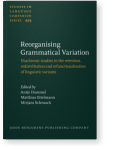Reorganising voice in the history of Greek
Split complexity and prescriptivism
In this study, I analyse the reorganisation of voice variation in Greek in terms of an increase or decrease in complexity. I support the view of split complexity (E[xternal]- vs. I[nternal]-complexity), and I add the role of parametric routes to the whole picture of grammatical complexity in cases of reorganisation of variation. In this respect, the new active anticausatives resulted in a lower degree of complexity in terms of derivation; conversely, the parametric route became more complex because a microparameter determines the lexically constrained group of active anticausatives. In terms of E-complexity, the option of this microparameter results in lower complexity because it is related to frequent elements. However, E-complexity is also affected by a prescriptive rule that favours elements that are less frequent (nonactive anticausatives).
Article outline
- 1.Introduction
- 2.Background on complexity: Contradictions and split complexity
- 2.1Contradictions in the analysis of complexity
- 2.2Split complexity
- 2.2.1E- vs. I-complexity
- 2.2.2Hypothesis of further split complexity: d-I- vs. p-I-complexity
- 3.Voice morphology variation in Greek and complexity
- 3.1Voice morphology in Greek
- 3.2Anticausatives in the Greek diachrony: an overview of a reorganisation
- 4.Split complexity and the (morpho-)syntax of Voice in Greek
- 4.1Processing results and corpus frequencies
- 4.2Parametric routes for Voice in Greek
- 4.3The role of prescriptivism
- 5.Conclusion
-
Acknowledgements
-
Notes
-
References
